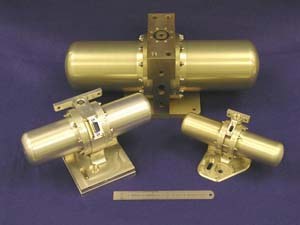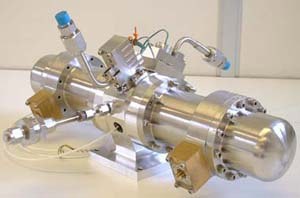Linear Compressors Research

Cryogenics
Linear Compressors
Cryocoolers consist of two distinct elements: the compressor and the cooler. The compressor supplies a pressure wave which is used to drive a closed thermodynamic cycle, which takes place in the cooler. The Oxford innovation which allowed the use of cryocoolers in long-life space applications was the development of a long life compressor based on spiral flexures. Since the development of these original compressors, research and development has continued as these components generally occupy the majority of a cryocooler's volume and mass - parameters which it is highly desirable to minimize in both space and tactical applications.
The new generation of Oxford linear compressors
The first generation of Oxford compressors were developed as part of a Stirling cycle cooler system for the ISAMS instrument carried aboard the UARS spacecraft (see the section on space cryocoolers). Since then a new type of compact linear motor and a new flexure spring design have been developed by the group for linear compressors with the aim of meeting the stringent requirements for high efficiency and low mass. The compressors are a key part of the High Efficiency Cryocooler (HEC) and have been jointly developed by the Cryogenic Engineering Group, Honeywell Hymatic, and TRW (now Northrop-Grumman Space Technology).
This design is considerably more rugged than previous machines and includes a fully controlled assembly and test process more suitable for repeated and consistent quantity production. Two of these balanced pairs were delivered by TRW to NASA/JPL for the IMAS project, and by 2002 at least 12 of the machines had been produced in a new 'production-line' process. New machines are also under continuous development to improve the range of sizes and powers available.

Valved Linear Compressor
The use of sub-mm and FIR detectors for astronomy and earth observation requires provision of temperatures below 12 K, typically aboard satellite borne instruments such as IRAS or CLAES. Traditionally these temperatures have been achieved by the use of stored cryogens such as super-fluid helium or solid hydrogen. Although this has several advantages, such as the absence of exported vibration; the systems are massive, inconvenient to accommodate, and have limited lifetimes (e.g. 300 days in the case of IRAS). There has recently, therefore, been considerable interest in extending the capabilities of mechanical coolers, which have demonstrated their long-life capabilities, into this temperature range. As part of the JPL/NASA sponsored ACTDP programme, Oxford has been collaborating with Northrop Grumman Space Technology (NGST), and Honeywell Hymatic to develop such a system.
Mechanical coolers used in space are generally based upon a linear compressor with clearance seals. This provides a pressure variation to drive a closed regenerative thermodynamic cycle such as the Stirling cycle or a Pulse Tube. Such compressors, used in conjunction with a pulse-tube pre-cooler, can also be used to obtain lower temperatures using the well known recuperative Joule-Thompson expansion process with the addition of a method of rectifying the oscillating gas flow. The group has therefore developed a prototype valved compressor, based on existing space-qualified cryocooler compressor technology jointly developed by Oxford, Honeywell Hymatic, and NGST.

Useful Links and References
- Reed J, Dadd M, Bailey P, Petach M, Raab J. Development of a valved linear compressor for a satellite borne J-T cryocooler. Submitted to Cryogenics. Abstract
